Snigdha Chaturvedi
Fundamental Limits of Perfect Concept Erasure
Mar 25, 2025Abstract:Concept erasure is the task of erasing information about a concept (e.g., gender or race) from a representation set while retaining the maximum possible utility -- information from original representations. Concept erasure is useful in several applications, such as removing sensitive concepts to achieve fairness and interpreting the impact of specific concepts on a model's performance. Previous concept erasure techniques have prioritized robustly erasing concepts over retaining the utility of the resultant representations. However, there seems to be an inherent tradeoff between erasure and retaining utility, making it unclear how to achieve perfect concept erasure while maintaining high utility. In this paper, we offer a fresh perspective toward solving this problem by quantifying the fundamental limits of concept erasure through an information-theoretic lens. Using these results, we investigate constraints on the data distribution and the erasure functions required to achieve the limits of perfect concept erasure. Empirically, we show that the derived erasure functions achieve the optimal theoretical bounds. Additionally, we show that our approach outperforms existing methods on a range of synthetic and real-world datasets using GPT-4 representations.
Coverage-based Fairness in Multi-document Summarization
Dec 11, 2024Abstract:Fairness in multi-document summarization (MDS) measures whether a system can generate a summary fairly representing information from documents with different social attribute values. Fairness in MDS is crucial since a fair summary can offer readers a comprehensive view. Previous works focus on quantifying summary-level fairness using Proportional Representation, a fairness measure based on Statistical Parity. However, Proportional Representation does not consider redundancy in input documents and overlooks corpus-level unfairness. In this work, we propose a new summary-level fairness measure, Equal Coverage, which is based on coverage of documents with different social attribute values and considers the redundancy within documents. To detect the corpus-level unfairness, we propose a new corpus-level measure, Coverage Parity. Our human evaluations show that our measures align more with our definition of fairness. Using our measures, we evaluate the fairness of thirteen different LLMs. We find that Claude3-sonnet is the fairest among all evaluated LLMs. We also find that almost all LLMs overrepresent different social attribute values.
SocialGaze: Improving the Integration of Human Social Norms in Large Language Models
Oct 11, 2024
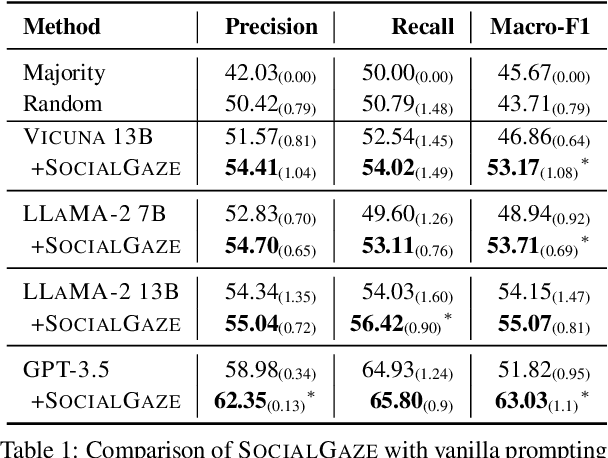

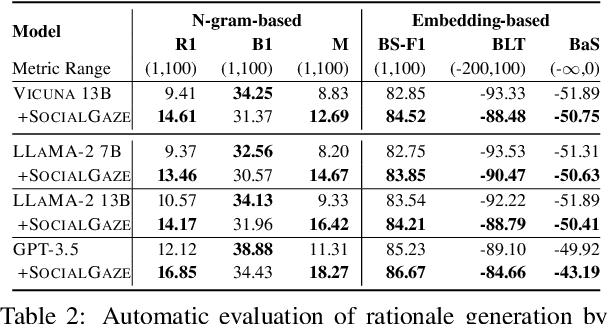
Abstract:While much research has explored enhancing the reasoning capabilities of large language models (LLMs) in the last few years, there is a gap in understanding the alignment of these models with social values and norms. We introduce the task of judging social acceptance. Social acceptance requires models to judge and rationalize the acceptability of people's actions in social situations. For example, is it socially acceptable for a neighbor to ask others in the community to keep their pets indoors at night? We find that LLMs' understanding of social acceptance is often misaligned with human consensus. To alleviate this, we introduce SocialGaze, a multi-step prompting framework, in which a language model verbalizes a social situation from multiple perspectives before forming a judgment. Our experiments demonstrate that the SocialGaze approach improves the alignment with human judgments by up to 11 F1 points with the GPT-3.5 model. We also identify biases and correlations in LLMs in assigning blame that is related to features such as the gender (males are significantly more likely to be judged unfairly) and age (LLMs are more aligned with humans for older narrators).
Structured Unrestricted-Rank Matrices for Parameter Efficient Fine-tuning
Jun 25, 2024



Abstract:Recent efforts to scale Transformer models have demonstrated rapid progress across a wide range of tasks (Wei et al., 2022). However, fine-tuning these models for downstream tasks is expensive due to their large parameter counts. Parameter-efficient fine-tuning (PEFT) approaches have emerged as a viable alternative by allowing us to fine-tune models by updating only a small number of parameters. In this work, we propose a general framework for parameter efficient fine-tuning (PEFT), based on structured unrestricted-rank matrices (SURM) which can serve as a drop-in replacement for popular approaches such as Adapters and LoRA. Unlike other methods like LoRA, SURMs provides more flexibility in finding the right balance between compactness and expressiveness. This is achieved by using low displacement rank matrices (LDRMs), which hasn't been used in this context before. SURMs remain competitive with baselines, often providing significant quality improvements while using a smaller parameter budget. SURMs achieve 5-7% accuracy gains on various image classification tasks while replacing low-rank matrices in LoRA. It also results in up to 12x reduction of the number of parameters in adapters (with virtually no loss in quality) on the GLUE benchmark.
Towards Scalable Exact Machine Unlearning Using Parameter-Efficient Fine-Tuning
Jun 24, 2024Abstract:Machine unlearning is the process of efficiently removing the influence of a training data instance from a trained machine learning model without retraining it from scratch. A popular subclass of unlearning approaches is exact machine unlearning, which focuses on techniques that explicitly guarantee the removal of the influence of a data instance from a model. Exact unlearning approaches use a machine learning model in which individual components are trained on disjoint subsets of the data. During deletion, exact unlearning approaches only retrain the affected components rather than the entire model. While existing approaches reduce retraining costs, it can still be expensive for an organization to retrain a model component as it requires halting a system in production, which leads to service failure and adversely impacts customers. To address these challenges, we introduce an exact unlearning framework -- Sequence-aware Sharded Sliced Training (S3T), designed to enhance the deletion capabilities of an exact unlearning system while minimizing the impact on model's performance. At the core of S3T, we utilize a lightweight parameter-efficient fine-tuning approach that enables parameter isolation by sequentially training layers with disjoint data slices. This enables efficient unlearning by simply deactivating the layers affected by data deletion. Furthermore, to reduce the retraining cost and improve model performance, we train the model on multiple data sequences, which allows S3T to handle an increased number of deletion requests. Both theoretically and empirically, we demonstrate that S3T attains superior deletion capabilities and enhanced performance compared to baselines across a wide range of settings.
Fast Tree-Field Integrators: From Low Displacement Rank to Topological Transformers
Jun 22, 2024Abstract:We present a new class of fast polylog-linear algorithms based on the theory of structured matrices (in particular low displacement rank) for integrating tensor fields defined on weighted trees. Several applications of the resulting fast tree-field integrators (FTFIs) are presented, including (a) approximation of graph metrics with tree metrics, (b) graph classification, (c) modeling on meshes, and finally (d) Topological Transformers (TTs) (Choromanski et al., 2022) for images. For Topological Transformers, we propose new relative position encoding (RPE) masking mechanisms with as few as three extra learnable parameters per Transformer layer, leading to 1.0-1.5%+ accuracy gains. Importantly, most of FTFIs are exact methods, thus numerically equivalent to their brute-force counterparts. When applied to graphs with thousands of nodes, those exact algorithms provide 5.7-13x speedups. We also provide an extensive theoretical analysis of our methods.
Exploring Safety-Utility Trade-Offs in Personalized Language Models
Jun 17, 2024



Abstract:As large language models (LLMs) become increasingly integrated into daily applications, it is essential to ensure they operate fairly across diverse user demographics. In this work, we show that LLMs suffer from personalization bias, where their performance is impacted when they are personalized to a user's identity. We quantify personalization bias by evaluating the performance of LLMs along two axes - safety and utility. We measure safety by examining how benign LLM responses are to unsafe prompts with and without personalization. We measure utility by evaluating the LLM's performance on various tasks, including general knowledge, mathematical abilities, programming, and reasoning skills. We find that various LLMs, ranging from open-source models like Llama (Touvron et al., 2023) and Mistral (Jiang et al., 2023) to API-based ones like GPT-3.5 and GPT-4o (Ouyang et al., 2022), exhibit significant variance in performance in terms of safety-utility trade-offs depending on the user's identity. Finally, we discuss several strategies to mitigate personalization bias using preference tuning and prompt-based defenses.
Returning to the Start: Generating Narratives with Related Endpoints
Mar 31, 2024Abstract:Human writers often bookend their writing with ending sentences that relate back to the beginning sentences in order to compose a satisfying narrative that "closes the loop." Motivated by this observation, we propose RENarGen, a controllable story-generation paradigm that generates narratives by ensuring the first and last sentences are related and then infilling the middle sentences. Our contributions include an initial exploration of how various methods of bookending from Narratology affect language modeling for stories. Automatic and human evaluations indicate RENarGen produces better stories with more narrative closure than current autoregressive models.
Rationale-based Opinion Summarization
Mar 30, 2024Abstract:Opinion summarization aims to generate concise summaries that present popular opinions of a large group of reviews. However, these summaries can be too generic and lack supporting details. To address these issues, we propose a new paradigm for summarizing reviews, rationale-based opinion summarization. Rationale-based opinion summaries output the representative opinions as well as one or more corresponding rationales. To extract good rationales, we define four desirable properties: relatedness, specificity, popularity, and diversity and present a Gibbs-sampling-based method to extract rationales. Overall, we propose RATION, an unsupervised extractive system that has two components: an Opinion Extractor (to extract representative opinions) and Rationales Extractor (to extract corresponding rationales). We conduct automatic and human evaluations to show that rationales extracted by RATION have the proposed properties and its summaries are more useful than conventional summaries. The implementation of our work is available at https://github.com/leehaoyuan/RATION.
Incremental Extractive Opinion Summarization Using Cover Trees
Jan 16, 2024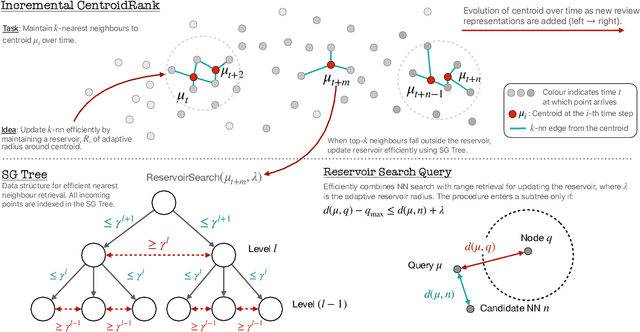
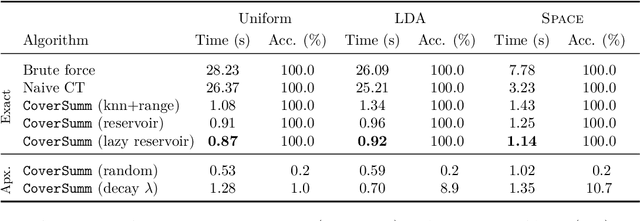

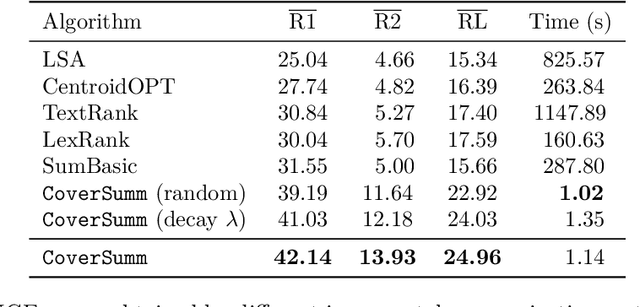
Abstract:Extractive opinion summarization involves automatically producing a summary of text about an entity (e.g., a product's reviews) by extracting representative sentences that capture prevalent opinions in the review set. Typically, in online marketplaces user reviews accrue over time, and opinion summaries need to be updated periodically to provide customers with up-to-date information. In this work, we study the task of extractive opinion summarization in an incremental setting, where the underlying review set evolves over time. Many of the state-of-the-art extractive opinion summarization approaches are centrality-based, such as CentroidRank. CentroidRank performs extractive summarization by selecting a subset of review sentences closest to the centroid in the representation space as the summary. However, these methods are not capable of operating efficiently in an incremental setting, where reviews arrive one at a time. In this paper, we present an efficient algorithm for accurately computing the CentroidRank summaries in an incremental setting. Our approach, CoverSumm, relies on indexing review representations in a cover tree and maintaining a reservoir of candidate summary review sentences. CoverSumm's efficacy is supported by a theoretical and empirical analysis of running time. Empirically, on a diverse collection of data (both real and synthetically created to illustrate scaling considerations), we demonstrate that CoverSumm is up to 25x faster than baseline methods, and capable of adapting to nuanced changes in data distribution. We also conduct human evaluations of the generated summaries and find that CoverSumm is capable of producing informative summaries consistent with the underlying review set.
 Add to Chrome
Add to Chrome Add to Firefox
Add to Firefox Add to Edge
Add to Edge